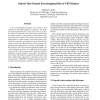Free Online Productivity Tools
i2Speak
i2Symbol
i2OCR
iTex2Img
iWeb2Print
iWeb2Shot
i2Type
iPdf2Split
iPdf2Merge
i2Bopomofo
i2Arabic
i2Style
i2Image
i2PDF
iLatex2Rtf
Sci2ools
SP
2002
IEEE
2002
IEEE
Optical Time-Domain Eavesdropping Risks of CRT Displays
A new eavesdropping technique can be used to read cathode-ray tube (CRT) displays at a distance. The intensity of the light emitted by a raster-scan screen as a function of time corresponds to the video signal convolved with the impulse response of the phosphors. Experiments with a typical personal computer color monitor show that enough high-frequency content remains in the emitted light to permit the reconstruction of readable text by deconvolving the signal received with a fast photosensor. These optical compromising emanations can be received even after diffuse reflection from a wall. Shot noise from background light is the critical performance factor. In a sufficiently dark environment and with a large enough sensor aperture, practically significant reception distances are possible. This information security risk should be considered in applications with high confidentiality requirements, especially in those that already require "TEMPEST"-shielded equipment designed to ...
Emitted Light | Optical Compromising Emanations | Security Privacy | Significant Reception Distances | SP 2002 |
| Added | 23 Dec 2010 |
| Updated | 23 Dec 2010 |
| Type | Journal |
| Year | 2002 |
| Where | SP |
| Authors | Markus G. Kuhn |
Comments (0)

